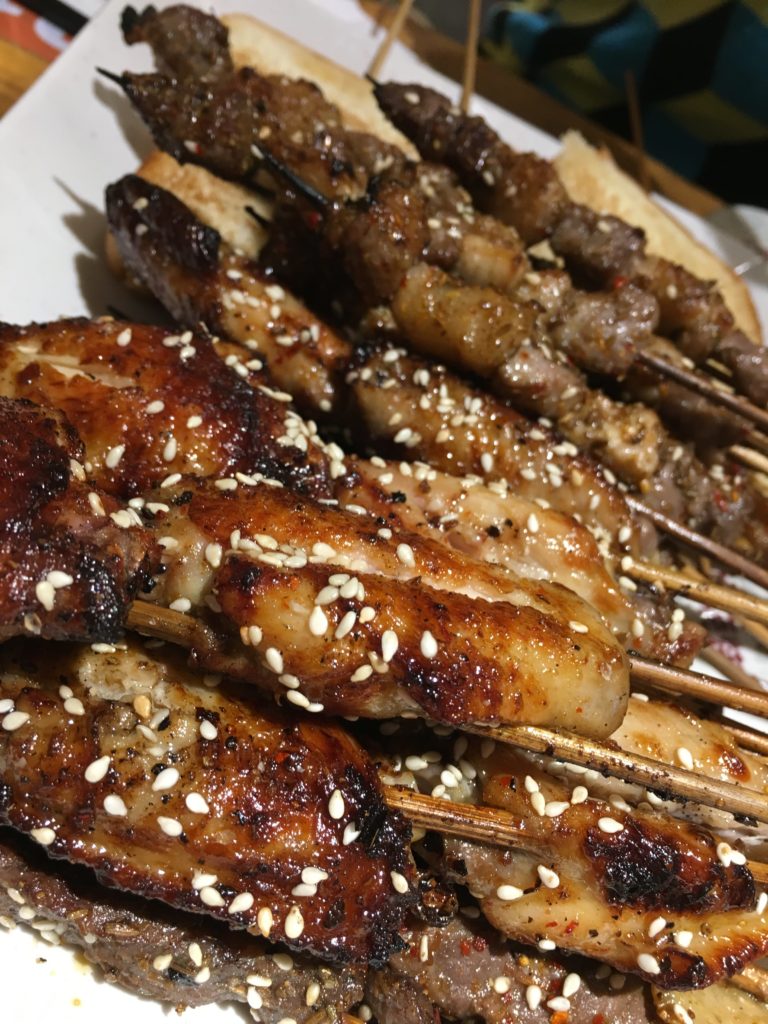China is a country where food is central to everything; the culture, daily life and any important holiday. When you consider that almost every town has its own local dish, it leaves an almost unimaginable number of culinary delicacies to sample. Obviously there are the so called ‘classic dishes,’ that most foreigners know; roast duck, sweet and sour, hot pot, noodles, dumplings, steamed buns, the list goes on and on. However there is one dish that most tourists seem to overlook or just miss altogether; Chuan (pronounced chwar).
Chuan is skewered meat cooked to perfection over an open fire, washed down with whatever cold beer the restaurant has in stock. It can be found almost anywhere in China, with many restaurants spilling onto the street during the summer. Restaurants serving chuan can easily identified by a bright neon character, 串, dangling outside
Although almost unknown amongst foreign tourists, this is one of the most popular dishes amongst expats and locals alike, with the most popular hotspots usually crowded until late into the night with people putting the world to rights over meat, beer and cigarettes.
In China eating internal organs, such as kidneys, intestines, hearts and stomach, is extremely common. Some of Chinas most famous dishes contain ingredients that would make the majority of westerns recoil in fear. After all, if eating internal organs is not common in your regular diet, it is unlikely to be something that you will really enjoy, its not a taste or texture you are familiar with. Similar to cheese in China; Cheese is popular amongst the younger generation as they have been exposed to it through western food, but not so amongst the older generation. Many people in thais age group find cheese repulsive due to its unfamiliar texture and taste, some have even said they feel it tastes like soap.
Glancing through a chuan menu you can see three clear levels of culinary bravery:
Level 1: Simple, appeals to both Chinese and western taste buds, no weird stuff here!
Level 2: As well as enjoying everything from level 1, level 2 includes some of the slightly odder meat concoctions that retain some sort of western-ish taste and texture.
Level 3: Oh my god, people will really eat that!? Cue photos of the menu being taken.
Obviously the above means nothing without knowing what could be on a chuan menu, so with that in mind lets delve in and see some of the most common dishes:
Level 1:
羊肉串 – Yangrouchuan – Chunks of lamb with seasoning and salt – size of the chunks can vary from restaurant to restaurant.
牛肉串 – Niurouchuan – Same as the above but beef instead of lamb.
鸡翅 – Jichi – Chicken wings with a variety of seasonings.
土豆片 – Tudoupian – Thin slices of potato grilled with special chuan seasoning.
Level 2:
脆鸡皮 – Cuijipi – Crispy chicken skin wrapped around a skewer.
羊肉筋 – Yangroujin – Lamb meat and tendon – This is amazing!
烤蒜 – Kaosuan – Roasted whole cloves of garlic.
脆骨 – Cuigu – Cartilage, usually its chicken cartilage, but it can also be beef or lamb.
烤虾 – Kaoxia – Roasted shrimp still in their shells, however you will notice that the vast majority don’t bother peeling the shrimp and simply eat the shells as well.
Level 3:
鸡心 – Jixin – Chicken hearts – Tastes a little like sausage strangely enough.
大腰 – Dayao – Kidney – A large lamb kidney skewered, roasted and seasoned.
羊鞭 – Yangbian – Lamb penis – definitely not for the faint hearted.
羊宝 – Yangbao – Occasionally translated as lambs treasure, these a two round delicacies are not hard to find, but surely this isn’t a hugely popular dish? Right?!
So with that in mind, after a long hard day of wondering around Beijing, hunt for that glowing 串 sign, grab a beer and start ordering. Take the opportunity to enjoy and sample this often overlooked and unknown area of Chinese cuisine!

